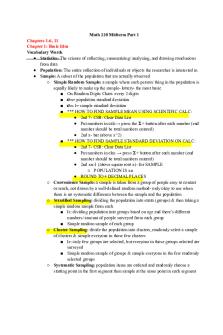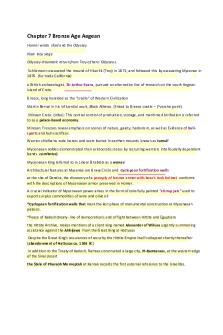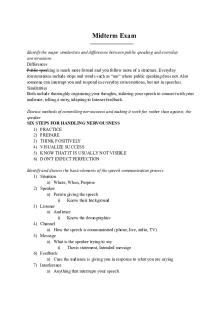Lin 1 study midterm - Julia Menard-Warwick- Professor PDF

| Title | Lin 1 study midterm - Julia Menard-Warwick- Professor |
|---|---|
| Author | Alexandra Vieille |
| Course | Intro to Linguistics |
| Institution | University of California Davis |
| Pages | 5 |
| File Size | 128.8 KB |
| File Type | |
| Total Downloads | 90 |
| Total Views | 122 |
Summary
Julia Menard-Warwick-
Professor...
Description
● language(s) as system(s) of arbitrary signs ○ Non-arbitrary signs: clouds indicating rain (logical causal relationship) consistent across languages ○ Arbitrary signs: traffic light (can be modified by society) inconsistent across languages ○ Language is an ex. because words can change meaning and because there are different languages ● signs=meaning (signified) + expression (signifier) ○ “Water” = sign ○ Saying “water” = utterance or expression ● 3 modalities=spoken, written, signed ○ Speech ■ Primary form of communication ■ can be accomplished without sight and without other physical capabilities, cannot span time without modern technologies ○ Writing -Pictograms Universal in any language ■ Secondary form ■ Writing is a form of communication that represents speech ■ Can be read or understood more quickly, lasts longer than speech and can be transported globally ○ Signing ■ Primary form of communication ■ Depends on hand shape, location and movement to depict different words ● meaning versus expression versus context ○ Expression encompasses words, phrases, and sentences, including intonation and stress. ○ Meaning refers to the senses and referents of those elements of expression ○ Context refers to the social situation (ex. Simple answer vs. request) ■ “Is there any salt on the table?” - guest asking at table, wants salt ■ “Is there any salt on the table?” - guest and host in kitchen, information is appropriate “Yes/No” ● descriptive/prescriptive grammar ○ descriptive grammar=words that proficient speakers actually use “ain’t” ○ prescriptive grammar=standardized language “are not” ● grammatical vs ungrammatical sentences ○ Grammatical sentences- anything that a proficient English speaker can understand/say “it’s me” “I ain’t got none” (not prescriptively grammatical but common enough to be grammatical) Ungrammatical sentences- utterances that cannot be said by English speakers “Experience different something allergy season this.”
● standardized language ○ The variety of language spoken by educated middle or upper class people who live in centers of commerce and government. ● language varieties, dialects, registers ○ Language varieties - a cover term for talking about any particular language, dialect, or register ○ Dialects - the language variety characteristic of a particular regional or social group, e.g. Texas English; Valley Girl English, Beijing "yuppie" Mandarin. ○ Registers - language characteristic of a particular situation, often professional, e.g. legal, medical, culinary ● grammatical competence versus communicative competence ○ Grammatical competence - implicit knowledge of vocabulary, pronunciation, sentence structure, and meaning. ○ Communicative competence - appropriate use of grammatical competence in communicative situations. ● language ideologies ○ An evaluation of language that serves the interest of a particular social group ● lexical categories (nouns, adjectives, adverbs, verbs, pronouns, determiners, prepositions, ○ Adverb: slowly ○ Pronoun: he/she/it ○ Determiner: the, a, that ○ Prepositions: above, across, by, below conjunctions) ● open vs closed word classes ○ Open class - words that change rapidly (nouns verbs and adjectives) ○ Closed class - words that change slowly (prepositions, pronouns, and determiners ● free vs bound morphemes ○ Morpheme: (un- true-th-ful-ness) 5 morphemes - each element changes lexical category of “true” r oot word ○ Free: morphemes that can stand alone - mother/orange ○ Bound morpheme: un-, tele-, -ness, and -er ● root morphemes ○ Simplest form of root word ■ Uncontrollably - control ■ Undeniably - denial ● prefixes, suffixes, affixes ○ Prefix - morpheme at the beginning of the word ○ Suffixes - morpheme at the end of the word
○ Affixes - suffix or prefix ● inflectional vs derivational morphemes ○ Inflectional: changes the form of a word but not it’s central meaning (boy/boys) (-s, -ed, -ing) ○ Derivational: derive new words - (true/untrue) (align/realign) changes central meaning (-un, -y, -ish, -ous) ● processes for deriving new words (affixes, compounds, shortening, acronyms, initialisms, blends, ○ Compound - two whole words combined into one new one “pay phone” ○ Shortening - a way to shorten a word/word phrase ○ Acronym - NATO, GIF (can be pronounced as a word) ○ Initialism - GPA (must be pronounced as individual letters) ○ Blend - a combination of two or more shortened parts of words to make new single word “biotech” biology and technology ● conversion or functional shift, semantic shift, borrowed words, invented words) ○ Functional shift - e-mail (noun)→to e-mail (verb) (change in lexical category) ○ Semantic shift - spam (cheap canned meat)→spam (unwanted, mass-produced email, noun)→spam (verb) (change in core meaning) ○ Borrowed words - naïve (French adjective→Englishadjective) ○ Invented words - youtuber (wasn’t a word until youtube was invented) ● Allomorphs - different pronunciations and/ or spellings of a morpheme ● subjects versus objects versus objects of prepositions ○ Subjects - the noun phrase that does the action (Su kicked the ball) ○ Objects - he noun phrase that receives the action (Su kicked the ball) ○ Objects of prepositions - the noun phrase that follows a preposition (Don slept under the bridge) ● subject and object pronouns, 1st, 2nd, and 3rd ○ Subject pronouns - I, she, he ○ Object pronouns - Me, her, him ● person, singular and plural ○ ● nominative and accusative case in Latin ○ Nominative - subject (the dog sees the boy) ○ Accusative - direct object (ends in m in latin “the dog sees the boy”) ● morphological problem solving ● transitive, intransitive, and copular verbs ○ Transitive verbs take a direct object: Su sees the wolf ○ Intransitive verbs do NOT take a direct object: Su laughs loudly ○ Copular - A verb expressing a relationship or state of being: He is a nerd ● sentence, phrase, clause
●
●
● ● ●
●
● ● ● ●
● ● ● ● ● ●
○ Phrase=one or more connected words ○ Clause=a string of words that has a subject and a verb ○ Sentence=one or more (grammatically connected) clauses Constituents ○ Constituents=phrases that are structural elements of sentences ○ sentences consist not of words, but of constituents ○ Noun phrases and verb phrases are examples of constituents. structural ambiguity ○ He sold the car to his brother in New York ○ this string of words has more than one possible interpretation and the ambiguity arises from its two possible constituent structures noun phrases, verb phrases, prepositional phrases syntax trees phrase structure expansion rules ○ NP→(DET) (ADJ) N (PP) ○ VP→ V (NP) (PP) ○ S→ NP AUX VP grammatical relations (subjects, objects, obliques) ○ Kevin drank the beer at home ○ Subject= the NP that is directly under S (Kevin) ○ Object=the NP that is directly under VP (the beer) ○ Oblique=the NP that is directly under PP (home) movement rules: yes/no questions ○ moving the auxiliary verb to a position before the subject NP relative clauses and noun clauses the vocal tract voiced and unvoiced consonants ○ Voiced consonants=your vocal chords vibrate when you say them: g, b, d, v, l, r, m, n.... ○ Voiceless/unvoiced consonants=your vocal chords do NOT vibrate when you say them: k, p, t, f.... place of articulation (labial, dental, labiodental, alveolar, postalveolar, velar, glottal) manner of articulation (stop, fricative, affricate, nasal, approximant) phonetic description of English consonants, based on voicing plus place and manner of articulation (e.g. [p] is a voiceless bilabial stop) phonetic description of Westcoast US English vowels (front, central, back, high, mid, low, rounded, tense, lax—e.g [u] is a high, back, tense, rounded vowel) 3 diphthongs of US English ○ [aj] as in ride ○ [aw] (as in loud) ○ [ɔj] (as in boy, toy)
● reading IPA for English consonants and vowels ● [ ] the “flap” in US English ● nasalized vowels in French - nasalizing the vowels in french changes the meaning that the nasal e and regular e are not minimal pairs and therefore are not allomorphs of the same morpheme ● tones in Mandarin - different tones change the meaning of the word being pronounced ma vs má...
Similar Free PDFs

Midterm Study Guide 1
- 11 Pages

Midterm 1 Study Guide
- 15 Pages

Midterm 1 Study Guide copy
- 10 Pages

ASL 1 Midterm Study Guide
- 7 Pages

Philosophy Midterm 1 Study Guide
- 10 Pages

Study Guide for Midterm 1
- 2 Pages

BA Midterm 1 Study Guide
- 12 Pages

Marketing Midterm 1 Study Guide
- 27 Pages

Midterm pt 1 study guide
- 20 Pages
Popular Institutions
- Tinajero National High School - Annex
- Politeknik Caltex Riau
- Yokohama City University
- SGT University
- University of Al-Qadisiyah
- Divine Word College of Vigan
- Techniek College Rotterdam
- Universidade de Santiago
- Universiti Teknologi MARA Cawangan Johor Kampus Pasir Gudang
- Poltekkes Kemenkes Yogyakarta
- Baguio City National High School
- Colegio san marcos
- preparatoria uno
- Centro de Bachillerato Tecnológico Industrial y de Servicios No. 107
- Dalian Maritime University
- Quang Trung Secondary School
- Colegio Tecnológico en Informática
- Corporación Regional de Educación Superior
- Grupo CEDVA
- Dar Al Uloom University
- Centro de Estudios Preuniversitarios de la Universidad Nacional de Ingeniería
- 上智大学
- Aakash International School, Nuna Majara
- San Felipe Neri Catholic School
- Kang Chiao International School - New Taipei City
- Misamis Occidental National High School
- Institución Educativa Escuela Normal Juan Ladrilleros
- Kolehiyo ng Pantukan
- Batanes State College
- Instituto Continental
- Sekolah Menengah Kejuruan Kesehatan Kaltara (Tarakan)
- Colegio de La Inmaculada Concepcion - Cebu






